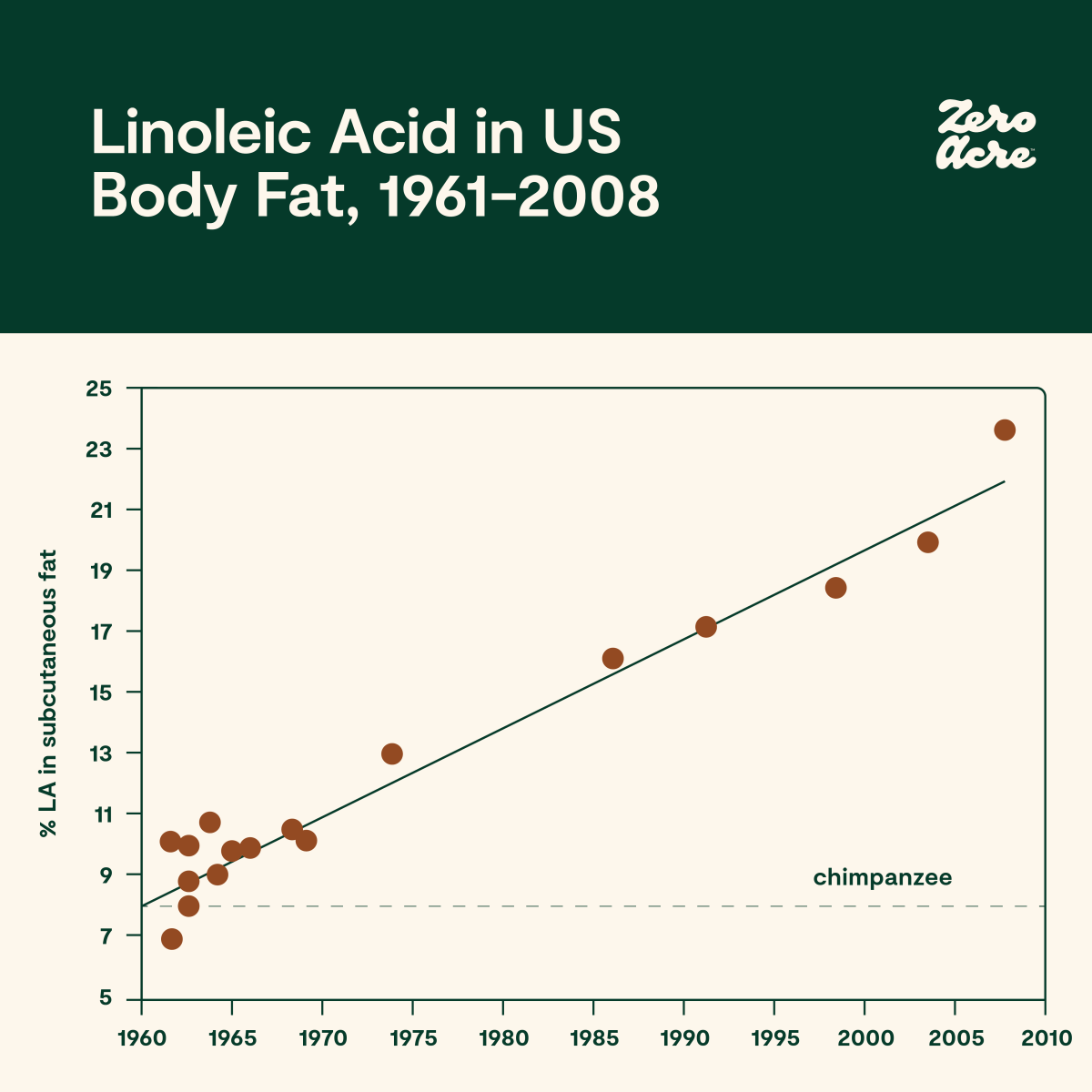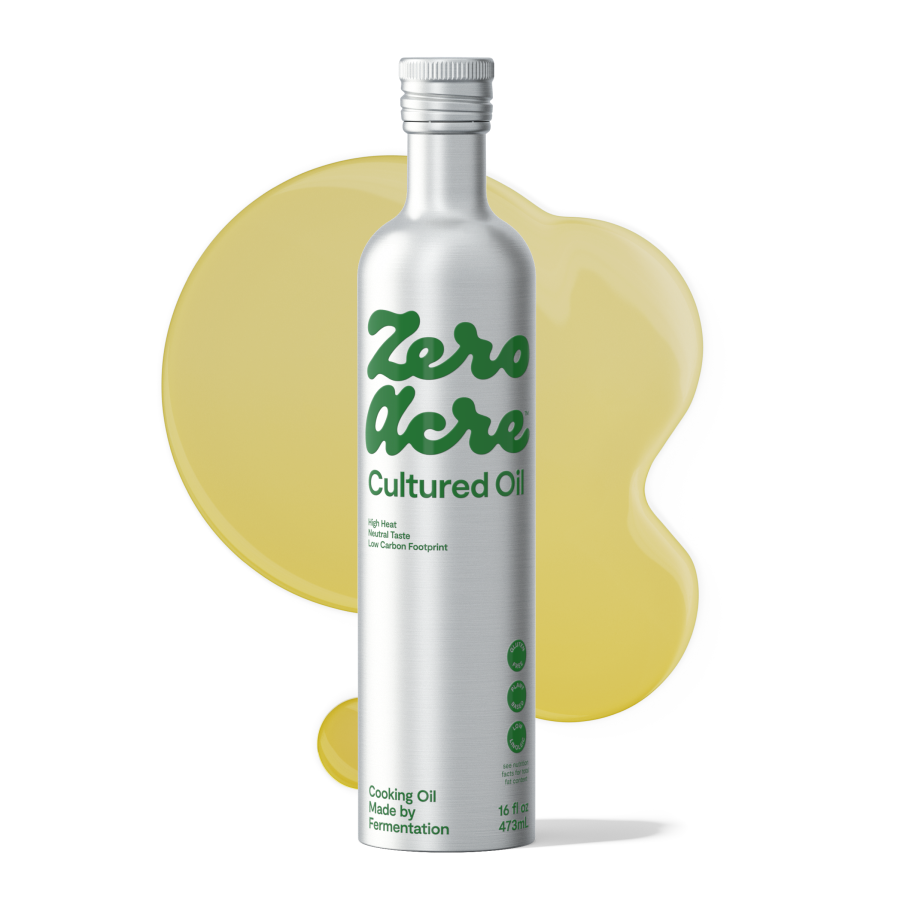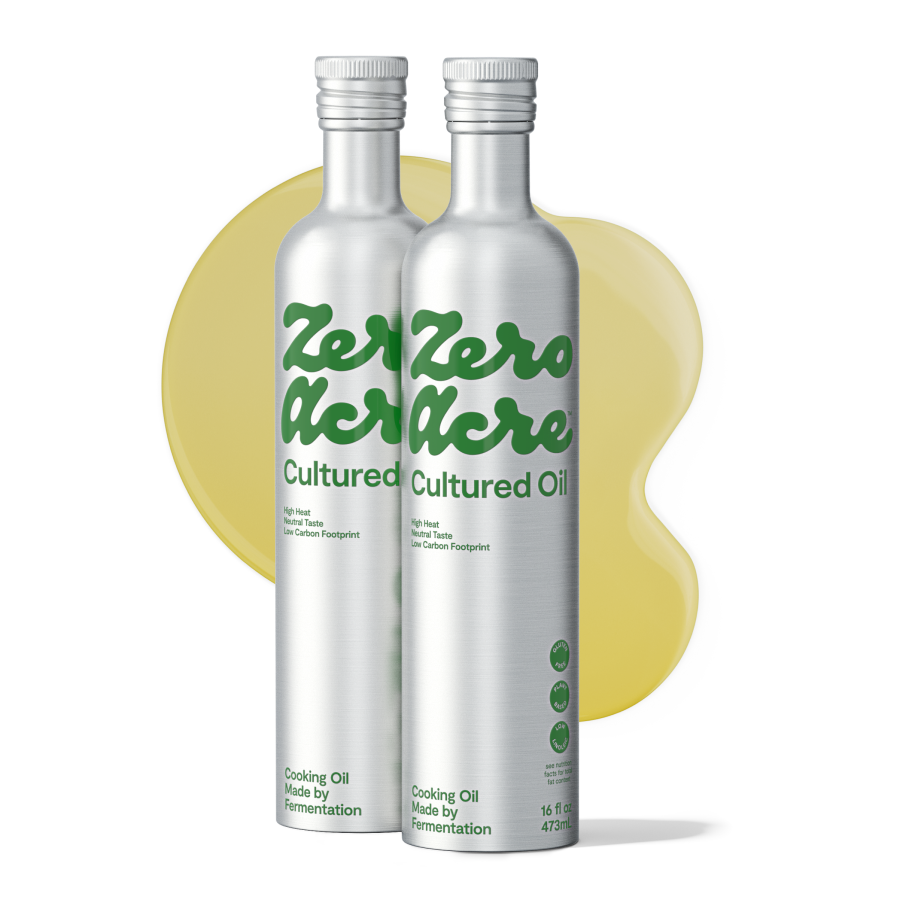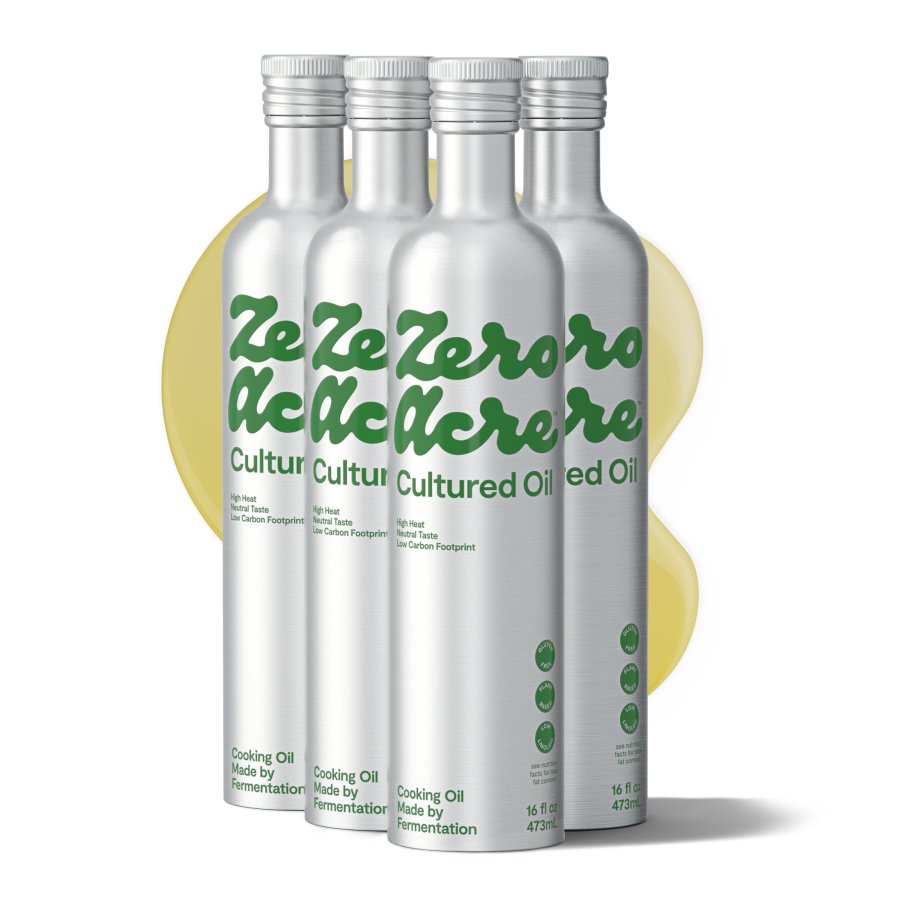WRITTEN BY: Corey Nelson
Article at a Glance
Grapeseed oil enjoys a reputation as a healthy cooking oil, but its fatty acid profile resembles other inflammatory seed oils such as sunflower, soybean, and corn oil.
Grapeseed oil contains approximately 70% omega-6 linoleic acid which makes it a poor choice for healthy cooking, compared to oils low in omega-6.
Excessive omega-6 intake from seed oils is linked to health problems including obesity, inflammation, and heart disease.
While grapeseed oil has a neutral taste and a high smoke point, there are healthier and more heat-stable oils available for cooks and chefs today.
Introduction
Grapeseed oil is a cooking oil made from grape seeds, usually as a byproduct of the winemaking process. With a neutral taste, relatively high smoke point, and possible health benefits due to polyphenols, this oil is garnering attention among chefs and home cooks.
However, grapeseed oil has some undesirable properties of which most people aren't aware — as a seed oil, it's high in unstable, inflammatory omega-6 fats.
Because polyunsaturated omega-6 fats break down easily when heated and form harmful byproducts, grapeseed oil isn't suitable for cooking. Excessive omega-6 intake from seed oils is also linked to health problems including inflammation, obesity, heart disease, and cancer.
In this guide, you'll learn answers to common questions about grapeseed oil, pros and cons, nutrition facts, studies, the important reasons that grapeseed oil isn't an ideal choice as an everyday cooking oil, and what to use instead.
What Is Grapeseed Oil?
Grapeseed oil is a light-colored vegetable oil made from the seeds of grape plants (Vitis vinifera L.). It's a pale, light yellow-green colored fat that's liquid at room temperature. This oil is high in polyunsaturated fats, vitamin E, and plant antioxidants called polyphenols [*,*].
Unlike a lot of cooking oils, grapeseed oil is neutral-tasting — it doesn't impart a flavor of its own to dishes. That’s a major reason a lot of people use grapeseed oil as a cooking oil, a base for salad dressing and sauces, and a topical ingredient for cosmetics and skin care products.
How is Grapeseed Oil Made?
Most grapeseed oil comes from wine pomace, the leftover solids that remain after pressing wine. Dried grape seeds contain 8-20% oil by weight [*]. Manufacturers separate them from pomace and use mechanical pressure, solvents, or a combination of these extraction methods [*].
Cold-pressed grapeseed oil is extracted using mechanical pressure with no heat or solvents [*]. This method results in a lower yield, but less damage to the unstable polyunsaturated fats and other natural constituents of the oil, such as antioxidants from grapes.
Grapeseed oil extracted with solvents is more economical, but using chemical solvents such as hexane poses environmental concerns [*]. In fact, solvents like hexane may cause air pollution and toxicity to both humans and the environment [*]. As a result, most people opt for cold-pressed oil for culinary purposes.
Is Grapeseed Oil a Seed Oil?
Yes, as you may have guessed, grapeseed oil is a seed oil. While grapeseed oil may have a reputation as a healthy cooking oil, it's got plenty in common with other seed oils like soybean, sunflower, and corn oil. All of these oils are high in omega-6 fats which don’t hold up well to high heat and are linked to inflammation and other health issues.
Grapeseed Oil Nutrition Facts
One tablespoon (14 grams) of grapeseed oil contains [*]:
125 calories (kcal)
0 grams of protein
14 grams of total fat
0 grams of carbs
0 grams of fiber
4-7 milligrams of vitamin E (alpha-tocopherol) [*].
Grapeseed oil is high in polyunsaturated omega-6 fats and low in monounsaturated and saturated fats. Each tablespoon provides approximately:
10 grams of omega-6 polyunsaturated fats
2.5 grams of monounsaturated fats, and
1.5 grams of saturated fats
Grapeseed oil is naturally high in vitamin E, with a tablespoon serving providing approximately 27%-47 of the recommended daily allowance (RDA) for men and women 14 years of age or older [*].
Pros and Cons of Grapeseed Oil
According to early research, grapeseed oil may have some health benefits due to its antioxidant content. However, this research doesn't necessarily account for the high amount of polyunsaturated omega-6 fats contained in the oil, which are linked to inflammation and other health problems.
Let's take a balanced look at the pros and cons of grapeseed oil in terms of health, flavor, culinary, and environmental properties.
Pro: High in Vitamin E and Plant Antioxidants
Grapeseed oil is high in alpha-tocopherol, an important form of vitamin E, providing 27-47% of the recommended daily allowance in a one-tablespoon serving [*,*].
It's also rich in other fat-soluble antioxidants related to vitamin E, known as tocopherols and tocotrienols [*]. Early research suggests that by protecting cells from damage, these compounds may be beneficial for brain, metabolic, and reproductive health [*]
Like grapes (and wine), grapeseed oil also contains plant antioxidants called polyphenols, including [*]:
Phytosterols including beta-sitosterol and stigmasterol
Anthocyanins like proanthocyanidin
These compounds appear to help protect cells from damage and could have cardiovascular, neurological, metabolic, and anti-cancer benefits [*,*].
The research into the health benefits of plant compounds is relatively new, but appears to be promising. However, it's worth noting that you can also obtain these and similar compounds by eating whole food fruits (including grapes) and vegetables, which have many additional proven health benefits [*].
Supplements high in polyphenols but without the polyunsaturated fats, such as grapeseed extract, are also available [*,*].
Con: High in Polyunsaturated Omega-6 Fats
Grapeseed oil may have a healthy reputation — but in reality, its fatty acid composition is almost identical to other industrial seed oils.
Like all seed oils, grapeseed oil is high in polyunsaturated omega-6 fat. It contains approximately 70% omega-6 linoleic acid, which is unstable and appears to cause inflammation when consumed in excess [*]. Compare that to Zero Acre oil, which has a linoleic acid content of under 3%.
Humans evolved to consume low levels of omega-6 fats in their diets, but as seed oils became popular in the 20th century, the average dietary intake increased 10-fold [*,*]. Consequently, the amount of omega-6 linoleic acid in our fat cells has risen alongside our increased consumption.
In 1960, omega-6 fats made up only 7-9% of our fat cells, but by 2008, it had increased to over 23% [*].

Your body incorporates omega-6 fats from grapeseed oil and other seed oils into cellular membranes, fatty tissue, and breast milk [*]. As a result, the excess linoleic acid bioaccumulates (builds up) in cells over time, resulting in instability and inflammation at the cellular level [*,*,*].
Studies show that eating too much omega-6 fat may contribute to:
Dementia or cognitive impairment [*]
Migraines and other types of chronic pain [*,*]
Over-consuming inflammatory omega-6 fats also creates an imbalance between omega-6 and omega-3 fats in your body and depletes anti-inflammatory omega-3s in tissues [*].
Researchers think that humans naturally evolved to consume an equal ratio of these fats, but today, many people now consume 20 times higher levels of omega-6 than omega-3 fats [*].

Pro: Neutral Flavor
Recipes often call for a neutral-tasting oil. From a culinary perspective, cooking oils that impart their own flavor into a dish aren't always desirable.
Think about the grassy, peppery notes of extra-virgin olive oil, or the sweet, tropical aromas of virgin coconut oil. While delicious, these flavors don't belong in every recipe.
The fact that grapeseed oil doesn't have a detectable taste is certainly one reason for its popularity. Chefs looking for an all-purpose oil that won't interfere with the other flavors of foods they're preparing may find it attractive.
That said, there are better alternatives for all-purpose cooking oils that are way lower in inflammatory fats, including Zero Acre oil, which is flavor-neutral. fresh-tasting, and rich in heart-healthy monounsaturated fats.
Con: Unstable During Storage and Heating
Because of its high polyunsaturated fatty acid content, grapeseed oil has low oxidative stability [*]. In other words, because polyunsaturated fats are inherently unstable, grapeseed oil is prone to breaking down and going rancid when stored, and especially when it’s heated.
Like other seed oils, grapeseed oil is very high in polyunsaturated fats. According to studies, it's even more prone to oxidation when stored or heated compared to other seed oils like corn, canola, or peanut oil [*].
Pro: Relatively Environmentally Friendly
In general, seed oils are bad news for the environment. Seed crop agriculture and the manufacturing and production of seed oils are significant causes of deforestation, habitat loss, water usage, and pollution.
But compared to other seed oils, grapeseed oil is relatively sustainable. Because most grapeseed oil is produced using waste products from the winemaking industry, its environmental impact is much lower.
While viticulture (wine production) is not without environmental impacts, it seems unlikely that people will stop drinking wine any time soon. As long as people continue to buy wine, grapeseed oil production from leftover wine solids doesn't add a significant burden.
One caveat: solvents like hexane that are used to extract grapeseed oil cause air pollution and toxicity to both humans and the environment [*]. Cold-pressed grapeseed oil doesn't contribute to solvent pollution, but unfortunately, most grapeseed oil production today is produced using solvent extraction.
Con: May Contain Traces of Solvents and Other Contaminants
Studies have found that commercially-available grapeseed oil products are often contaminated with harmful chemicals, including:
Traces of hexane or other solvents left over from extraction [*]
Mineral oil paraffins [*]
Phthalates [*]
Polyaromatic hydrocarbons (PAHs) [*]
Buying cold-pressed grapeseed oil is the best way to avoid solvent contamination, but it may not help with other types of contaminants.
According to some researchers, grapeseed is more likely to be contaminated with PAHs than most cooking oils because the raw material is dried prior to oil extraction [*]. The drying process can create smoke that comes into contact with the material. PAHs are lipophilic (attracted to fats) and concentrate in grapeseed oil during extraction, even when cold-pressed [*].
Another reason for the PAH contamination of grapeseed oil that the grape pomace (leftover solid material) is often compressed with a bulldozer for storage purposes prior to extraction, which can result in contamination with engine exhaust or motor oil [*].
Pro: Benefits of Topical Grapeseed Oil
Eating a diet rich in omega-6 seed oils may contribute to skin problems including inflammation, premature aging, acne, melanoma, and more.
On the other hand, polyunsaturated fats aren't so bad when applied topically to skin — and may even have some benefits when used for cosmetic or skin care purposes.
While research into topical grapeseed oil is relatively new, evidence does suggest that the tocopherols, tocotrienols, and plant antioxidants in this oil could help support skin health and appearance [*,*,*].
Some studies have also shown benefits to applying topical omega-6 oils similar to grapeseed oil to restore barrier function and hydrate skin [*].
Is Grapeseed Oil Healthy?
Grapeseed oil may be touted as a healthy fat, and there's a limited amount of research that suggests the tocopherols, tocotrienols, and plant antioxidants in this oil are good for humans. However, there aren't any large-scale human studies investigating the health effects of eating grapeseed oil.
Equally importantly, grapeseed oil is very high in omega-6 linoleic acid — an unstable polyunsaturated fat that, when consumed in excess, is linked with inflammation, obesity, heart disease and other health problems including cancer [*,*,*,*,*,*,*,*,*,*,*].
Due to the prevalence of common, inexpensive seed oils like soybean oil, sunflower oil, and corn oil in the modern, industrialized food system, humans today are eating at least 10 times more omega-6 fats than ever before [*,*].
While grapeseed oil is relatively uncommon in restaurants and packaged foods and thus not as big a contributor to excess omega-6 intake as other seed oils on average, its fatty acid composition is still very similar to other seed oils.
It's likely true that the plant-based antioxidants in grapeseed oil have beneficial health properties, but keep in mind that you can increase your consumption of whole food fruits (including grapes!) and vegetables to obtain similar or greater benefits — without the inflammatory omega-6 fats found in grapeseed oil.
There's no good reason to further increase your intake of omega-6 fats by using grapeseed oil when there are other proven (and likely less expensive) ways to get plant-based antioxidants that are equally good or better for your health.
Grapeseed Oil Smoke Point and Heat Stability
The smoke point of grapeseed oil is approximately 420-445°F [*]. While grapeseed oil has a fairly high smoke point, this doesn't tell you everything you need to know — in fact, it's not very stable when heated and can produce harmful byproducts during high-heat cooking, even when it's not smoking.
An oil's smoke point is the temperature at which it starts to visibly smoke when heated. Home cooks and chefs typically use the smoke point to determine whether or not a given cooking oil is a good choice for high-heat sauteing, pan-frying, or deep-frying foods.
In general, the smoke point is the absolute upper limit of the usable temperature range of an oil. In other words, an oil's smoke point is the maximum usable temperature for cooking, and you should always avoid heating it past that point.
That said, a relatively high smoke point actually doesn't mean an oil is stable when heated. While it may seem to be true that oils with higher smoke points should be better for high-heat cooking, this often isn't the case in reality.
The thermal oxidative stability — or heat stability — is how slowly or quickly a cooking oil breaks down when heated [*]. And in fact, heat stability doesn't correlate directly to an oil's smoke point, but rather to the fatty acid composition of an oil.
Of the common types of fatty acids, saturated fats are the most heat-stable, followed by monounsaturated fats, while polyunsaturated fats are the least heat-stable [*].
Grapeseed oil and other seed oils are high in unstable polyunsaturated fats that oxidize or break down rapidly when heated (including during manufacturing and cooking), forming unhealthy oxidation byproducts such as acrylamides, toxic aldehydes, hydroxylinoleate, free radicals, and trans fats [*,*].
Grapeseed Oil for Frying
Grapeseed seed oil is a poor choice for deep-frying and other high-heat cooking because it's extremely unstable when heated [*]. As a result of its poor stability, it forms harmful byproducts as soon as it's heated, and even more so when reheated multiple times.
Consuming foods fried in omega-6 seed oils is associated with higher risks of cancer, heart disease, and death from all causes [*].
Healthier frying oils you can use at home include Zero Acre oil, avocado oil, and coconut oil. You also may be able to reduce the negative health effects of eating fried foods by discarding your frying oils after high-heat cooking instead of reusing them.
Grapeseed Oil Substitutes
Adding healthy seed oil alternatives to your diet to replace grapeseed oil and other seed oils is an easy way to reduce your inflammatory omega-6 intake, including:
Avocado oil
Coconut oil
Extra-virgin olive oil
Replacing seed oils with oils that are suitable for deep-frying is also a wise choice, as polyunsaturated omega-6 seed oils are inherently unstable and create harmful oxidation byproducts during high-heat cooking.
When you're looking for healthy fats and oils, shop for products that are low in omega-6 fats, environmentally friendly, and offer properties that work for your intended application (such as a high smoke point and good heat stability for all-purpose cooking oils).
Unlike most seed oils, grapeseed oil does offer some potential health benefits due to its high antioxidant content, including tocopherols and tocotrienols (compounds related to vitamin E) and polyphenols (plant antioxidants) [*,*].
But instead of relying on grapeseed oil, you can easily obtain similar or better health benefits by:
Eating plenty of fresh fruits [*]
Consuming adequate amounts of vegetables [*]
Taking grape seed extract or other plant extract supplements, which contain polyphenol compounds without the high levels of omega-6 fats [*,*].
The Takeaway
Grapeseed oil enjoys a reputation as a healthy cooking oil, but it's got a similar fatty acid profile to other seed oils like sunflower, soybean, and corn oil.
Seed oils are found in most processed foods and restaurant meals, and most people are consuming 10 times more than the healthy amount [*,*]. Reducing your omega-6 linoleic acid intake by eliminating seed oils is a wise choice for better health.
If you're looking to increase your intake of plant-based antioxidants, eating more fresh fruits and veggies or even taking grapeseed extract supplements are better options than eating grapeseed oil.

Is Canola Oil Bad for You?
Canola oil is a seed oil derived from the rapeseed plant, and it contains problematic levels of the inflammatory omega-6 fat linoleic acid.

Cooking Oil Smoke Points: A Practical Guide for Cooks and Chefs
The smoke point of oil is the temperature at which it starts smoking. Choosing cooking oils with the right smoke points is crucial for cooking and for your health.

Are Seed Oils Toxic? The Latest Research Suggests Yes
Seed oils never underwent safety testing for premarket approval. Here, we examine the disturbing toxicity and safety data that have come to light recently.


